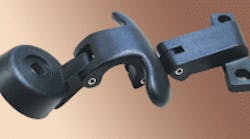Authored by: |
Hinges are ubiquitous mechanical components and, typically, engineers are most familiar with those with a solid pin. Many may not know, however, that a leading use of coiled-spring pins is in hinges because they match or exceed the performance of solid pins while lowering costs. Here are some simple guidelines for using coiled pins in hinge designs.
Basic types
In general, hinges come in two basic types:
Free fit. A free-fit hinge has little to no friction or drag when the latch or handle rotates. Hinge components are free to rotate independent of one another.
Friction fit. A friction-fit hinge requires interference to prevent free rotation of components relative to one another. Depending on design intent, resistance can vary from a slight drag to a level sufficient to hold components in a fixed position anywhere along their full range of rotation.
Coiled-spring pins are well suited for both hinge types. But regardless of the type of pin, engineers should minimize the gap between hinged components to reduce clearance and avoid bending the pin.
Free fit
For free-fit hinges, the coiled pin’s preinstalled diameter is of minor importance because the retaining, or smallest, holes in the pawl or handle determine the final pin diameter. Coiled pins are functional springs, so designers must consider recovery and retention in free-fit applications. The amount of recovery/retention depends on the diameter of the retaining (tight) hole and the “free span” of the pin. Free span is the distance a pin passes through a free-fit component. As free span increases, the pin diameter will also increase as it “recovers” a portion of its preinstalled diameter. See the accompanying “Free-fit hinge” graphic for more details.
For better load distribution and closer-tolerance hinges, the tight fit of the coiled pin should be in the outer members of the hinge (pawl section). The minimum thickness of the outer members should be 1 to 1.5 times the diameter of the pin. If the thickness of the outer members is less than the pin diameter, then the tight fit should be in the inside hole.
To design a free-fit hinge, first establish maximum hole size in the retaining component for a tight fit. Insert the coiled pin into the retaining component and measure the free diameter of the pin at the center of the span. Add a clearance factor to provide room for the rotating member, usually 0.001 in. (0.02 mm) to determine the minimum diameter of the free hole. Then add the required production tolerance to assign the maximum diameter of the free hole.
If the tight fit is on the inside member of the assembly, the pin’s two ends become sized and unsized as it is installed (handle section). The end of the pin that does not pass through the hole is larger than the end that has been sized by the hole. Therefore, measure the diameter of the unsized end to determine the minimum diameter of the free hole in the outside members.
Friction fit
In a friction-fit hinge, all holes should be sized identically within the assigned tolerances. If the manufacturer is unable to maintain the same hole size within each component, split the tolerance between the components. Common practice is to assign the smaller half of the tolerance to the outside holes and larger half to the inside hole.
A coiled pin simplifies design as there is no need to accommodate misalignment between holes to ensure friction, as is the case with rigid, solid pins. Nonetheless, coiled pins perform best when installed in straight, properly aligned holes. The coiled pin’s spring characteristics ensure consistent performance and maintain desired fit and function throughout the life of the product.
To ensure a friction fit with solid pins, on the other hand, the designer has to purposely offset or misalign the holes to get a “tight” feel. Then, because the pin is rigid, what started out as a tight fit will, over time, gradually loosen (referred to among hinge engineers as a “flopper”). This is particularly true in plastic hinges.
Because coiled pins can absorb wide hole tolerances, hinge manufacturers can loosen their tolerance requirements, which results in lower costs. In addition, coiled pins are conducive for automatic feeding and assembly and tend to be easier to insert than solid pins.
Finally, if the hinge sees cyclic or dynamic loads, the coiled pin is the only press-fit pin that can absorb shock and vibration and isolate the hinged components from these loads. This results in fewer maintenance headaches and longer assembly life. Taken together, coiled pins can significantly improve hinge performance as well as generate savings in overall manufacturing and operating costs.
